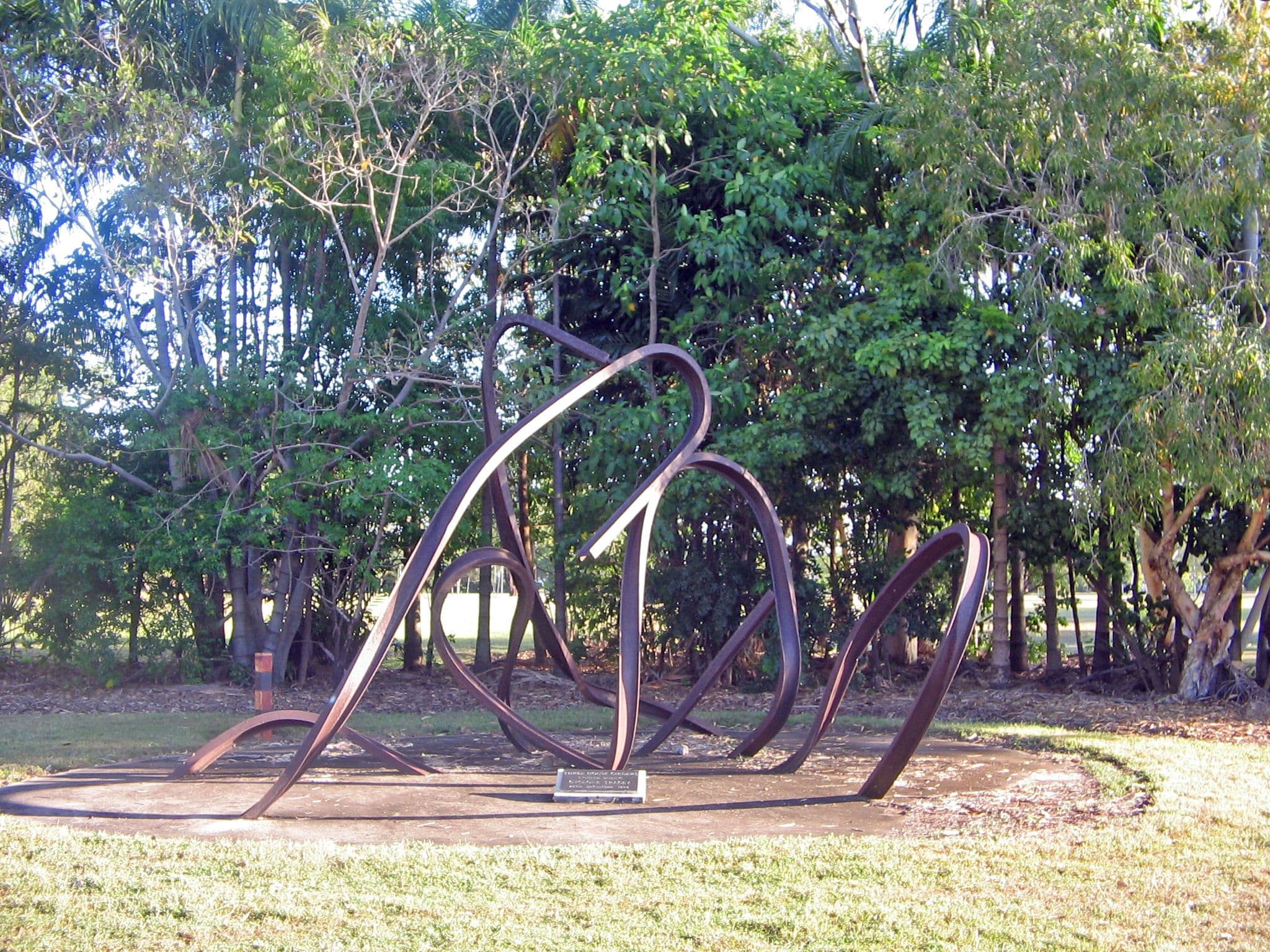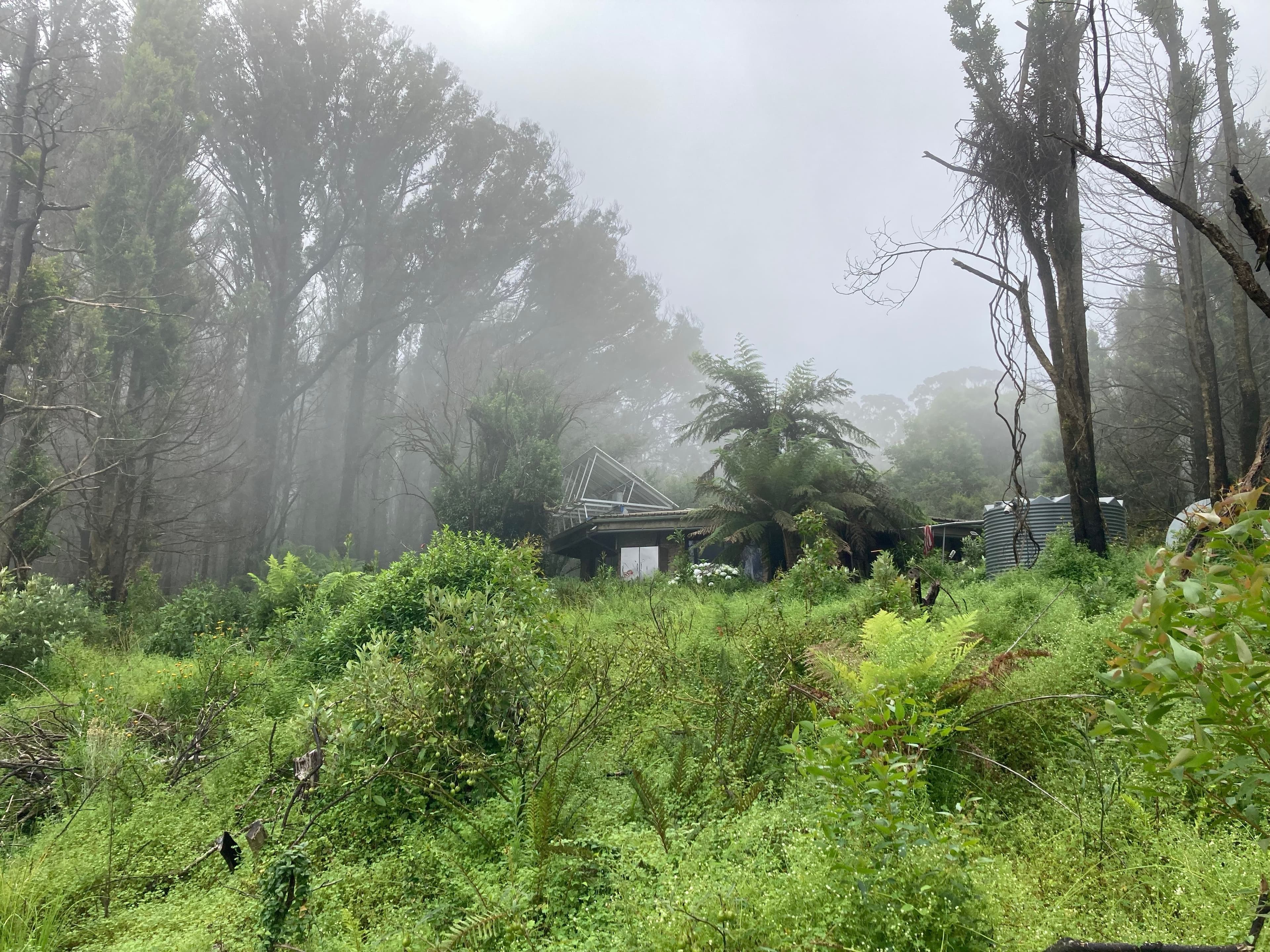Sculpting Air
[ Lauren Burrow ]
At the edge of the oval of the public high school in Darwin, Larrakia Country, sits a large public artwork that falsely resembles a generic piece of late-modernist sculpture. It’s made from three rusty I-beams that twist dynamically and elegantly into an arcing formation.

Three House Girders twisted during Tropical Cyclone Tracey on 25th December 1974, Photograph: Bidgee
It dips in and out of a concrete base like mangrove roots. A plaque reveals that this sculpture’s maker is tropical Cyclone Tracy, which hit Darwin in 1974 with an intensity such that these ‘Three House Girders’ were stripped from their house and warped into a spiralling formation by the wind. A teacher at the high school decided to have the piece set in concrete as a monument to those who died in the cyclone. The sculpture resurfaced in my memory when I was watching Fred Moten’s lecture about American artist Thornton Dial’s work A Monument to the Minds of the Little Steel Workers (2001–03):
This highly wrought, well-wrought, overwrought iron, folded or filled with air and flowers [is] like the skeleton of a Charles Babbage fantasy. The difference engine that Mr. Dial built and designed; in a kind of critical transcendence of private property and of monocultural violence.
In both Dial’s sculpture and Three House Girders, sculpture has the capacity to elucidate the fullness of air at the edges of difference and material conditions of an absolute poverty—what is there when ‘nothing’ is left.
When I was a teenager, Three House Girders felt compelling not only because of the violence flowing through its stillness, but because it had no author, an aesthetics in spite of human individualism. These days, I recall the tangled steel beams and I’m enamoured by the notion that the air—the wind—is the sculptor and how aesthetics can be used to interpret and enunciate climatic events, where air is a powerful agent capable of producing moments of significant physical consequence, conferred in the sculptural primacy of force as it traverses material (in)difference.
Just as air is a sculptor, it can be sculpted. And you can’t talk of air being a sculptor in the tropics without considering its antagonistic inverse: the dripping air-con unit, a mechanical moulder of air. In some of my past work I’ve collected the drips from air-cons at my studio or the gallery in which I’m exhibiting, returning the water to vessels in the room it was squeezed out of in an attempt to trace the air-con’s function as a congenital sculptor of a familiar yet placeless space. The machine conditions a space, much like a louvre does, but with a markedly different incentive. This sculpture of air is embedded in a preservationist attitude towards time. Performing the pretence that time can be divorced from space, museological ‘environmental management’ attempts to protect objects of all kinds from decomposition by the forces of heat and humidity. The air-con in its sculpture of air enables the universalising impetus of colonialism (which International Modernism is bound up in) and heightens the fiction of individuation, of people, rooms, climates, places.
In her text Shadow Places and the Politics of Dwelling (1996), Australian environmental philosopher Val Plumwood elaborates the role of the air conditioner in the global extractive circuit:
We must smell a bit of wrecked Ogoniland in the exhaust fumes from the air-conditioner, the ultimate remoteness, put-it-somewhere-else-machine. On the Neidjie criterion, we would have to accept all these shadow places too as ‘our’ place, not just the privileged, special, recognised place, the castle-of-the-self-place called home.
Plumwood cites Gagadju Elder Bill Neidjie’s philosophy of kinship with place to criticise the role emotional projections play in the fictitious individuation of settler-colonial selfhood, projections emanating from internalised colonial values of conquering ground, anywhere, and calling it home.
On the one hand, in removing moisture and other particles from the air, the air-con sculpts a climatic consistency that literally shifts the atmosphere inside a room by pumping it outside, replacing it with cool, dry air. On the other, a second displacement occurs in the materials composing the body of the air-conditioner itself which, as alluded to by Plumwood, are mined, severed, from a ‘shadow place’—in her example, Nigeria—the ecological specificity of which is abstracted and concealed through exploitative labour, mineral refinement, industrial standardisation and global trade.
When sorting through Plumwood’s archive with other members of the collective that maintains her house as a living archive on Walbunja Country, I was pleased when I found a ratty copy of Kenneth Frampton’s essay “Towards a Critical Regionalism: Six points for an architecture of resistance” from the book it was originally published in: Hal Foster’s The Anti-Aesthetic (1983).

Val Plumwood’s hut, Walbunja Country, February 2022. Photo: Lauren Burrow
In my own narrativisations of sculpture and air, I had previously conjured an imaginary dialogue between Plumwood’s discussion of the air-con and Frampton’s analysis of its deleterious cultural role in the trickle-down legacy of International Modernist architecture. Here, in the form of a mouldy photocopy, the relationship between the two thinkers is material memory, revealing significant overlaps between environmental philosophy and art theory.
Elaborating these previously imaginary linkages, Frampton writes,
Clearly, the main antagonist of rooted culture is the ubiquitous air-conditioner, applied in all times and in all places, irrespective of the local climatic conditions which have a capacity to express the specific place and the seasonal variations of its climate. Wherever they occur, the fixed window and the remote-controlled air-conditioning system are mutually indicative of domination by universal technique.
Frampton ties the air-conditioner’s spatiotemporal command to the realm of aesthetics where artworks are reduced to commodities and the “environment must conspire to render the work placeless,” aspiring for a compromise in gallery architecture that avoids the “injurious effects of direct sunlight” but where “the ambient light of the exhibition volume changes under the impact of time, season, humidity, etc,” to produce a place-conscious poetic. Because air is ubiquitous and varied the universal technique is always an attempt to regulate the totality of our experience of it. Plumwood extends Frampton’s proposition beyond art galleries to engulf the materiality of social identity more broadly.
Having spent time in Plumwood’s personal library, I’ve gotten to know her as a witty, animated and often harsh writer of critical marginalia. In books and articles that she read, Plumwood would scribble notes with a pen in the blank spaces of the pages that frame, interrupt and support texts. In a sense these spaces are like the air round the words, if we are to think of air as a material strata, often relegated to the ‘background’ due to the nature of its support for the actions of more discrete/less expansive agents (humans, other animals, objects, buildings). Plumwood draws a star and underlines Frampton’s paragraph: “It is clear that the liberative importance of the tactile resides in the fact that it can only be encoded in terms of experience itself: it cannot be reduced to mere information, to representation or to the simple evocation of a simulacrum substituting for absent presents.” She scribbles an addition in the margin: “so cannot be instrument of power.” The air-con generalises air into an entity measurable by informational categories of ‘pressure’, ‘humidity’ and ‘temperature’. Through its containment, measurement, theorisation and narrative, air becomes more tangible but also governable, at least conceptually.
Plumwood’s house, which she and her friends built with stones collected from the surrounding forest floor in the 1970s, relies on passive efforts at climate control. The gorgeous domestic library of over 3,000 ecological, philosophical, feminist, activist and decolonial texts lines the walls in bookshelves, encircling the room. Someone told me that the house was based on a monastic reading room and the books were arranged like this as a form of insulation from the cold of the mountain. In the warmer seasons, sliding glass doors set into every wall of the octagonal hut can be opened to allow for the passage of breeze in all directions. Air and the creatures that occasionally come with it (micro-bats, birds, funnel-web spiders, centipedes, flies, mosquitos, antichinus, wombats, frogs) flow through the doors.
The library poses a unique challenge for the committee and the effort to maintain an archive foregrounded by a framework that values the preservation of Plumwood’s legacy with an equal commitment to ecologically situated practice, which does not necessarily favour material preservation. Some especially rare books are sent to the air-conditioned archives at the Australian National University. But most of the library is kept in the place that Plumwood left it, steadily decomposing into mould and dust in collaboration with the mountain’s breath. Rather than isolating air quality to control temperature and humidity, air in this library is a condition that is just one of many interconnected factors, where sculptures by and of air are not mutually exclusive objects.
Notes
Fred Moten, An Ecology of (Eloquent) Things, Newfields, 2011, https://www.youtube.com/watch?v=1oRKOhlMmKQ&ab_channel=Newfields. Monument to the Minds of the Little Steel Workers is a 1930 x 3505 x 1168 mm sculpture (about the size of a small trailer) of proliferating steel curlicues hand-wrought by the artist. Slipping between signifying a sprawling bouquet of flowers and an “eloquent” tangle of scrap metal, the sculpture references the vernacular sculptures made by Black steel workers to adorn graveyards, and the role of these workers in the development of American industry.
Val Plumwood, “Shadow Places and the Politics of Dwelling,” in Australian Humanities Review,Issue 44, Canberra: ANU Press, 2008.
Kenneth Frampton, "Towards a Critical Regionalism: Six points for an architecture of resistance," in Anti-Aesthetic. Essays on Postmodern Culture, Seattle: Bay Press, 1983.
Frampton, "Towards a Critical Regionalism".
Artist & Educator
Lauren Burrow
Lauren Burrow is an artist and educator who graduated with a Masters of Fine Art (Sculpture) from the Milton Avery Graduate School of the Arts, Bard College, New York, in 2019. Through sculpture and installation, Burrow uses scrap materials including glass, plastic and water to investigate flows between the urban and the rural, the individual and the collective, the social and the ecological. She has held exhibitions at PLI, Munich (2022), Holden Garage, Berlin (2021), and TCB Art Inc, Melbourne (2019) and her work has been included in group exhibitions at LaTrobe Art Institute (2023), Queensland Art Gallery | Gallery of Modern Art (2023), the Australian Centre of Contemporary Art, Melbourne (2021), and Hessel Museum of Art, New York (2021). In 2023, Burrow was awarded an Anne and Gordon Samstag International Visual Arts Scholarship, enabling her candidacy in the PhD in Practice at the Academy of Fine Arts, Vienna.